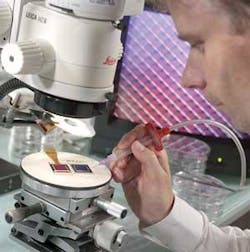By John Keller
Ask military optoelectronic-systems designers what they want most in lenses, and you will often hear rugged, lightweight, small size, and low cost. In the near future a technology called electrowetting may deliver these qualities and more.
Electrowetting, a technology pursued seriously thus far by only a handful of companies worldwide, seeks to blend fluids and electricity to shape liquid into the form of an optical lens. This approach, which can produce a lens for observation, filtering light, switching optical signals, or focusing a laser, is of interest to military-systems designers because it can be very small, has no moving parts, is inherently rugged, and uses electrical power in very low amounts.
Only about three companies are involved in electrowetting technology - Philips in The Netherlands, Lucent Technologies in Murray Hill, N.J., and Varioptic in France. Various research agencies and universities also are looking into the utility of electrowetting for a variety of military and commercial applications.
Researchers at Lucent are using electro-wetting for optical coupling from one optical fiber to another using liquid.
Electrowetting is based on how an electric field can modify the shape and wetting behavior of a drop of liquid in contact with an insulated electrode. A surface energy gradient caused by a nonuniformly applied electric field can manipulate a drop located between two plates.
Researchers have found ways to manipulate liquid droplets in this way to create a lens with changeable focal lengths, and that can even zoom in on images. These electrowetting lenses also could focus lasers and perform a wide variety of other light-processing tasks.
Researchers at Varioptic, for example, are looking into electrowetting to create relatively inexpensive and rugged lenses for camera phones by using just a few drops of oil and water. “We can tune the shape of the drop to create a lens. Think about a tunable lens, like the human eye,” says Etienne Paillard, chief executive officer of Varioptic.
Varioptic’s approach uses the oil and water - two liquids of equal density - contained between two windows in a conical container. The water conducts electricity, while oil contains the water like a lid, which enables designers to use a fixed volume of water while stabilizing the optical axis.
The interface between the oil and water changes shape depending on the voltage applied. With no electricity applied, the water surface stays flat, but at 40 volts the surface is highly convex, Paillard explains. Such a lens uses one-tenth the power of a motorized auto focus lens.
Varioptic officials say they are building prototypes of an electrowetting cell-phone camera lens now, and may have an auto-focus lens on the market as early as next year, and a year after that may make an electrowetting auto-focus lens with zoom capability available.
Yet cell-phone cameras may be only the beginning. “The most important application you might envision with military implications are opto and optoelectronic, at least as it looks right now,” says Thomas Jones, professor of electrical engineering and an electrowetting researcher at the University of Rochester in Rochester, N.Y.
“The most exciting application in electrowetting is these pixel-based visual displays to replace LCDs cheaper,” Jones says. “It could be a step toward electronic paper - a real cheap, flexible display that would operate on low voltages.”




